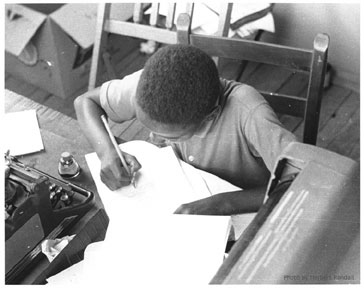
 |
||
|
|
|
|
|
|
||

Photo: “Writing in Freedom School,”
by Herbert Randall, 1964
Provided by the McCain Library and Archives, University of Southern Mississippi
Reprinted with permission of Herbert Randall
NEGRO HISTORY STUDY QUESTIONS
20TH CENTURY
At the beginning of the century Negroes faced the threat of a complete apartheid system of caste. The white power structure was robbing them of the right to vote, subjecting them to intense economic exploitation, and grinding out segregation statutes, which made public humiliation of Negroes the outstanding feature of Southern life.
With court decisions and executive orders the national government supported this sectional drive. Economic pressure, mob violence, and hundreds of lynchings reinforced by terror the attack on Negro self-respect and the individual will to resist.
Against these odds Negroes continued their tenacious struggle to be free, as they made significant essential advances. Insistence on their own human dignity featured the literature of the new period. Lynchers were driven first into the constricting uniforms of the Southern police, and driven even there into public light. In the freer climate of the North, a militant Negro intelligentsia publicized Southern terror and attacked bigotry and terror in the North.
In Northern cities voting Negroes learned again the lessons of Reconstruction; political rights did not automatically free them from grinding poverty. Important victories of the first half of the century, however, had created an articulate educated leadership which turned its face to the Negro poor to devise methods and programs which would make equality a manageable goal.
Study questions for this period are by no means exhaustive, and they undoubtedly overlook important basic themes. The questions are largely based on two books; A Pictorial History of the Negro in the United States, Langston Hughes, Editor, and J. W. Schulte Nordholt, The People That Walk in Darkness. The latter is a Ballantine Paperback; both books were chosen for their availability rather than for academic excellence. Vol. II of Aptheker’s Documents is useful for the first ten years of the century. Page references, when given, follow the initials of the editor or author.
I. Leadership
1. Who was Booker T. Washington? As he addressed Negroes in the midst of the campaign of white terror, what recommendations did he make about (a) political activity and (b) economic effort? H: 244; A: 877-79; N: 230-36
2. Who was W.E.B. DuBois? Summarize his criticism of Washington. H: 248-50; A: 877-79; N: 230-36.
3. Show how each of the following encouraged Negroes as a whole to approve the DuBois style of leadership:
a. the lynching record and H: 256-57, 266-67, 235; A: 792-804
white reaction N: 243-54. 223
b. The migration to the North N: 241-44
c. Negro participation in World War I. N: 238-39; H: 262-66
d. Negro Economic conditions, 1900-1930:
1. housing
2. income and employment
3. Laissez-faire politics
II. Lynching
Lynching became a common practice in the years when Negroes were driven from the polls. It is necessary to examine this incredibly brutal practice in detail, in order to appreciate the full extent of white efforts to destroy Negro self-respect. Against this backdrop, when lynchings took place at the rate of one, two, and three a week for forty years, Negro survival and growth assumes heroic proportions.
Teachers and students should read the following material before working out the study questions: H: 233-34, 256-57, 266-67; A: 792-804; N: 243-53
1. Consult an Almanac to find out the record of lynching in the U.S.
2. Show how each of the following encouraged lynching:
a. race reporting practices of the press.
b. poor white living standards.
c. respectable Southern and Northern moderates.
d. greed. (N: 201)
3. Describe the most important achievements of Northern Negroes in silencing or otherwise resisting the lynch cry. H: 246, 267; N: 245_47
4. What steps did Southern Negroes take to keep these terrorists at bay? H: 232-233; A: 792-804
III. The Struggle for Dignity and Self-Respect
The caste system has consistently encouraged the Negro to lose faith in his own powers. It is helpful to note some of the ways in which the system works.
1. What is a racial stereotype? How did the career of Bert William illustrate the evils of stereotyping? Name some other stereotypes. How did Katherine Dunham cut through this confusing fog? N: 263, 269; H: 272-79; N: 260-80
2. Relate the Harlem Renaissance of the Twenties to the question of stereotyping. H: 272-79; N: 260-80.
3. Show how Negroes destroyed many stereotypes
(a) in World War I H: 262-6
(b) in educational developments
(c) in the new style of race riots. H: 267
4. What economic problems perpetuated stereotypes?
5. Questions on Jazz—it’s origins and influence.
IV. Economic Problems
Negroes lost many important gains of Reconstruction days because they had failed to wrest from the government an economic foundation for their political freedoms. This was a costly failure; ever since, problems of the Negro masses have to a large degree been problems of the poor.
1. Show how Southern emphasis on agriculture intensified Negro poverty in the Twenties and Thirties. N: 282-84
Why did cotton prices steadily decline?
Explain why the prices of manufactured goods which the poor had to buy remained high even during depressions.
2. Why is segregated education poor education? Show how Southern educational practices weakened the ability of city migrants to secure jobs.
3. Northern Negroes who voted continued to send their children to segregated schools. To what extent do Negro economic conditions help to account for this situation?
The document is from:
SNCC, The Student Nonviolent Coordinating Committee Papers, 1959-1972 (Sanford, NC: Microfilming Corporation of America, 1982) Reel 67, File 340, Page 1081.
The original papers are at the King Library and Archives, The Martin Luther King Jr. Center for Nonviolent Social Change, Atlanta, GA